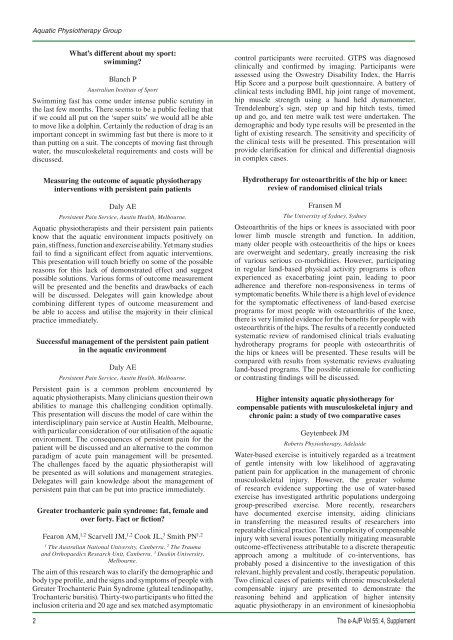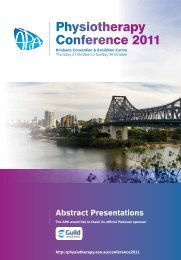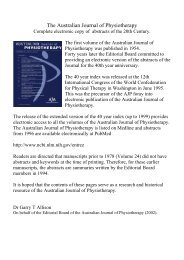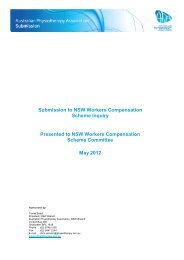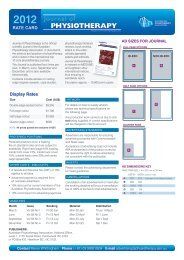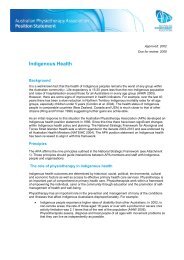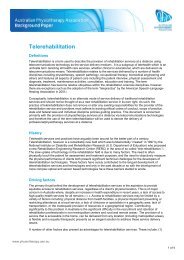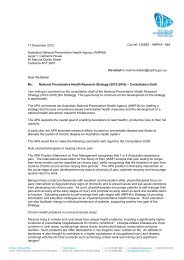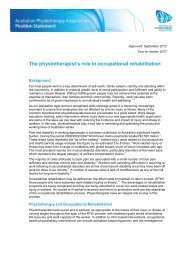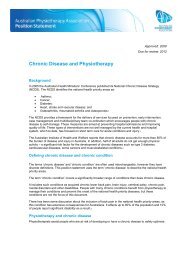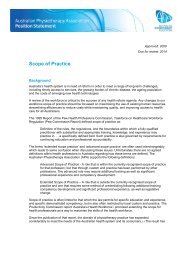2009 APA Conference Week Abstracts - Australian Physiotherapy ...
2009 APA Conference Week Abstracts - Australian Physiotherapy ...
2009 APA Conference Week Abstracts - Australian Physiotherapy ...
You also want an ePaper? Increase the reach of your titles
YUMPU automatically turns print PDFs into web optimized ePapers that Google loves.
Aquatic <strong>Physiotherapy</strong> Group<br />
2<br />
What’s different about my sport:<br />
swimming?<br />
Blanch P<br />
<strong>Australian</strong> Institute of Sport<br />
Swimming fast has come under intense public scrutiny in<br />
the last few months. There seems to be a public feeling that<br />
if we could all put on the ‘super suits’ we would all be able<br />
to move like a dolphin. Certainly the reduction of drag is an<br />
important concept in swimming fast but there is more to it<br />
than putting on a suit. The concepts of moving fast through<br />
water, the musculoskeletal requirements and costs will be<br />
discussed.<br />
Measuring the outcome of aquatic physiotherapy<br />
interventions with persistent pain patients<br />
Daly AE<br />
Persistent Pain Service, Austin Health, Melbourne.<br />
Aquatic physiotherapists and their persistent pain patients<br />
know that the aquatic environment impacts positively on<br />
pain, stiffness, function and exercise ability. Yet many studies<br />
fail to find a significant effect from aquatic interventions.<br />
This presentation will touch briefly on some of the possible<br />
reasons for this lack of demonstrated effect and suggest<br />
possible solutions. Various forms of outcome measurement<br />
will be presented and the benefits and drawbacks of each<br />
will be discussed. Delegates will gain knowledge about<br />
combining different types of outcome measurement and<br />
be able to access and utilise the majority in their clinical<br />
practice immediately.<br />
Successful management of the persistent pain patient<br />
in the aquatic environment<br />
Daly AE<br />
Persistent Pain Service, Austin Health, Melbourne.<br />
Persistent pain is a common problem encountered by<br />
aquatic physiotherapists. Many clinicians question their own<br />
abilities to manage this challenging condition optimally.<br />
This presentation will discuss the model of care within the<br />
interdisciplinary pain service at Austin Health, Melbourne,<br />
with particular consideration of our utilisation of the aquatic<br />
environment. The consequences of persistent pain for the<br />
patient will be discussed and an alternative to the common<br />
paradigm of acute pain management will be presented.<br />
The challenges faced by the aquatic physiotherapist will<br />
be presented as will solutions and management strategies.<br />
Delegates will gain knowledge about the management of<br />
persistent pain that can be put into practice immediately.<br />
Greater trochanteric pain syndrome: fat, female and<br />
over forty. Fact or fiction?<br />
Fearon AM, 1,2 Scarvell JM, 1,2 Cook JL, 3 Smith PN 1,2<br />
1<br />
The <strong>Australian</strong> National University, Canberra. 2 The Trauma<br />
and Orthopaedics Research Unit, Canberra. 3 Deakin University,<br />
Melbourne.<br />
The aim of this research was to clarify the demographic and<br />
body type profile, and the signs and symptoms of people with<br />
Greater Trochanteric Pain Syndrome (gluteal tendinopathy,<br />
Trochanteric bursitis). Thirty-two participants who fitted the<br />
inclusion criteria and 20 age and sex matched asymptomatic<br />
control participants were recruited. GTPS was diagnosed<br />
clinically and confirmed by imaging. Participants were<br />
assessed using the Oswestry Disability Index, the Harris<br />
Hip Score and a purpose built questionnaire. A battery of<br />
clinical tests including BMI, hip joint range of movement,<br />
hip muscle strength using a hand held dynamometer,<br />
Trendelenburg’s sign, step up and hip hitch tests, timed<br />
up and go, and ten metre walk test were undertaken. The<br />
demographic and body type results will be presented in the<br />
light of existing research. The sensitivity and specificity of<br />
the clinical tests will be presented. This presentation will<br />
provide clarification for clinical and differential diagnosis<br />
in complex cases.<br />
Hydrotherapy for osteoarthritis of the hip or knee:<br />
review of randomised clinical trials<br />
Fransen M<br />
The University of Sydney, Sydney<br />
Osteoarthritis of the hips or knees is associated with poor<br />
lower limb muscle strength and function. In addition,<br />
many older people with osteoarthritis of the hips or knees<br />
are overweight and sedentary, greatly increasing the risk<br />
of various serious co-morbidities. However, participating<br />
in regular land-based physical activity programs is often<br />
experienced as exacerbating joint pain, leading to poor<br />
adherence and therefore non-responsiveness in terms of<br />
symptomatic benefits. While there is a high level of evidence<br />
for the symptomatic effectiveness of land-based exercise<br />
programs for most people with osteoarthritis of the knee,<br />
there is very limited evidence for the benefits for people with<br />
osteoarthritis of the hips. The results of a recently conducted<br />
systematic review of randomised clinical trials evaluating<br />
hydrotherapy programs for people with osteoarthritis of<br />
the hips or knees will be presented. These results will be<br />
compared with results from systematic reviews evaluating<br />
land-based programs. The possible rationale for conflicting<br />
or contrasting findings will be discussed.<br />
Higher intensity aquatic physiotherapy for<br />
compensable patients with musculoskeletal injury and<br />
chronic pain: a study of two comparative cases<br />
Geytenbeek JM<br />
Roberts <strong>Physiotherapy</strong>, Adelaide<br />
Water-based exercise is intuitively regarded as a treatment<br />
of gentle intensity with low likelihood of aggravating<br />
patient pain for application in the management of chronic<br />
musculoskeletal injury. However, the greater volume<br />
of research evidence supporting the use of water-based<br />
exercise has investigated arthritic populations undergoing<br />
group-prescribed exercise. More recently, researchers<br />
have documented exercise intensity, aiding clinicians<br />
in transferring the measured results of researchers into<br />
repeatable clinical practice. The complexity of compensable<br />
injury with several issues potentially mitigating measurable<br />
outcome-effectiveness attributable to a discrete therapeutic<br />
approach among a multitude of co-interventions, has<br />
probably posed a disincentive to the investigation of this<br />
relevant, highly prevalent and costly, therapeutic population.<br />
Two clinical cases of patients with chronic musculoskeletal<br />
compensable injury are presented to demonstrate the<br />
reasoning behind and application of higher intensity<br />
aquatic physiotherapy in an environment of kinesiophobia<br />
The e-AJP Vol 55: 4, Supplement


